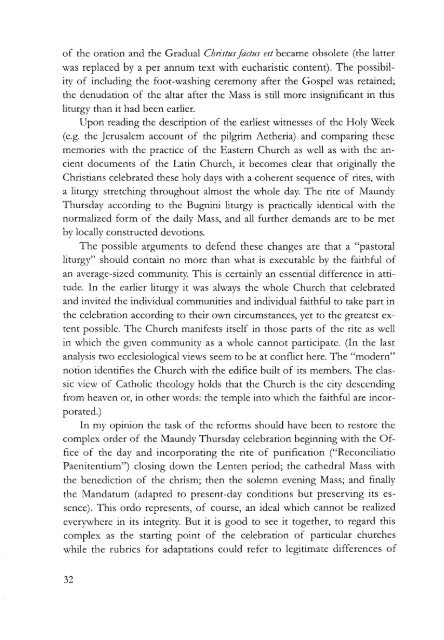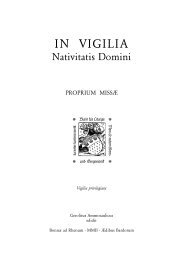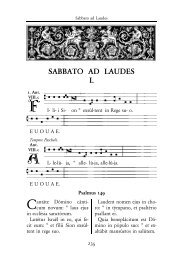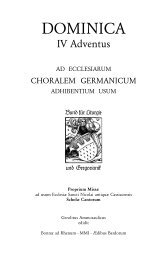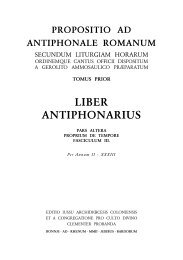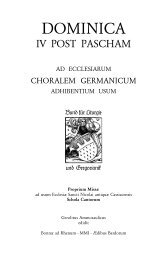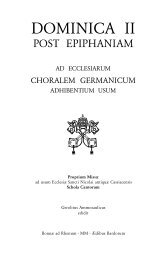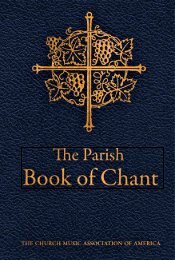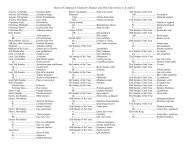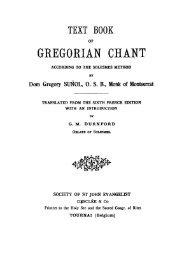The Bugnini-Liturgy and the Reform of the Reform - MusicaSacra
The Bugnini-Liturgy and the Reform of the Reform - MusicaSacra
The Bugnini-Liturgy and the Reform of the Reform - MusicaSacra
Create successful ePaper yourself
Turn your PDF publications into a flip-book with our unique Google optimized e-Paper software.
<strong>of</strong> <strong>the</strong> oration <strong>and</strong> <strong>the</strong> Gradual Christus factus est became obsolete (<strong>the</strong> latter<br />
was replaced by a per annum text with eucharistic content). <strong>The</strong> possibility<br />
<strong>of</strong> including <strong>the</strong> foot-washing ceremony after <strong>the</strong> Gospel was retained;<br />
<strong>the</strong> denudation <strong>of</strong> <strong>the</strong> altar after <strong>the</strong> Mass is still more insignificant in this<br />
liturgy than it had been earlier.<br />
Upon reading <strong>the</strong> description <strong>of</strong> <strong>the</strong> earliest witnesses <strong>of</strong> <strong>the</strong> Holy Week<br />
(e.g. <strong>the</strong> Jerusalem account <strong>of</strong> <strong>the</strong> pilgrim Ae<strong>the</strong>ria) <strong>and</strong> comparing <strong>the</strong>se<br />
memories with <strong>the</strong> practice <strong>of</strong> <strong>the</strong> Eastern Church as well as with <strong>the</strong> ancient<br />
documents <strong>of</strong> <strong>the</strong> Latin Church, it becomes clear that originally <strong>the</strong><br />
Christians celebrated <strong>the</strong>se holy days with a coherent sequence <strong>of</strong> rites, with<br />
a liturgy stretching throughout almost <strong>the</strong> whole day. <strong>The</strong> rite <strong>of</strong> Maundy<br />
Thursday according to <strong>the</strong> <strong>Bugnini</strong> liturgy is practically identical with <strong>the</strong><br />
normalized form <strong>of</strong> <strong>the</strong> daily Mass, <strong>and</strong> all fur<strong>the</strong>r dem<strong>and</strong>s are to be met<br />
by locally constructed devotions.<br />
<strong>The</strong> possible arguments to defend <strong>the</strong>se changes are that a "pastoral<br />
liturgy" should contain no more than what is executable by <strong>the</strong> faithful <strong>of</strong><br />
an average-sized community. This is certainly an essential difference in attitude.<br />
In <strong>the</strong> earlier liturgy it was always <strong>the</strong> whole Church that celebrated<br />
<strong>and</strong> invited <strong>the</strong> individual communities <strong>and</strong> individual faithful to take part in<br />
<strong>the</strong> celebration according to <strong>the</strong>ir own circumstances, yet to <strong>the</strong> greatest extent<br />
possible. <strong>The</strong> Church manifests itself in those parts <strong>of</strong> <strong>the</strong> rite as well<br />
in which <strong>the</strong> given community as a whole cannot participate. (In <strong>the</strong> last<br />
analysis two ecclesiological views seem to be at conflict here. <strong>The</strong> "modern"<br />
notion identifies <strong>the</strong> Church with <strong>the</strong> edifice built <strong>of</strong> its members. <strong>The</strong> classic<br />
view <strong>of</strong> Catholic <strong>the</strong>ology holds that <strong>the</strong> Church is <strong>the</strong> city descending<br />
from heaven or, in o<strong>the</strong>r words: <strong>the</strong> temple into which <strong>the</strong> faithful are incorporated.)<br />
In my opinion <strong>the</strong> task <strong>of</strong> <strong>the</strong> reforms should have been to restore <strong>the</strong><br />
complex order <strong>of</strong> <strong>the</strong> Maundy Thursday celebration beginning with <strong>the</strong> Office<br />
<strong>of</strong> <strong>the</strong> day <strong>and</strong> incorporating <strong>the</strong> rite <strong>of</strong> purification ("Reconciliatio<br />
Paenitentium") closing down <strong>the</strong> Lenten period; <strong>the</strong> ca<strong>the</strong>dral Mass with<br />
<strong>the</strong> benediction <strong>of</strong> <strong>the</strong> chrism; <strong>the</strong>n <strong>the</strong> solemn evening Mass; <strong>and</strong> finally<br />
<strong>the</strong> M<strong>and</strong>atum (adapted to present-day conditions but preserving its essence).<br />
This ordo represents, <strong>of</strong> course, an ideal which cannot be realized<br />
everywhere in its integrity. But it is good to see it toge<strong>the</strong>r, to regard this<br />
complex as <strong>the</strong> starting point <strong>of</strong> <strong>the</strong> celebration <strong>of</strong> particular churches<br />
while <strong>the</strong> rubrics for adaptations could refer to legitimate differences <strong>of</strong><br />
32


